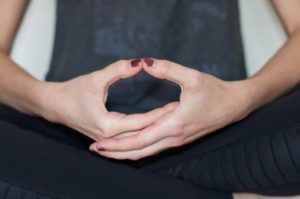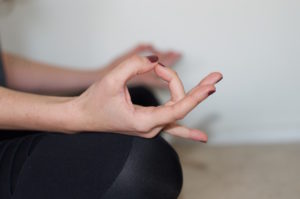As published in Yoga Guide Magazine, edition 3 (Jan 2018)
Mudras are powerful positions of the body that can influence the subtle energy flow (prana) throughout the body and brain. The Sanskrit word, mudra, translates to mean “seal,” “symbol” or “gesture.”
Mudras have played an important part in Hindu and Buddhist cultures for centuries. The rich history of sacred hand gestures can be seen across the world in ancient statues, paintings and temples.
In yoga, we utilize mudras to draw our attention deeper inside and channel energy flow to enhance our health and state of mind. Although some mudras may involve the whole body, they are most often practiced by holding precise hand and finger placements while meditating. With practice and patience, mudras can stimulate specific channels in our energetic body leading to improved physical, mental and spiritual wellbeing.
- Thumb represents the universal self, and the element of space/ether (akasha)
- Index finger represents the individual self, and the element of air (vayu)
- Middle finger represents the intellect or intuition, and the element of fire (agni)
- Ring finger represents the mind, and the element of water (jala)
- Pinky finger represents the physical body, and the element of earth (prthvi)
Although there are over 100 mudras, performing the following hand positions during your meditation is a great start to your practice. Begin by sitting in a comfortable posture such as sukhasana (simple cross legged position) or seated upright in a chair. As you hold your mudra, close your eyes, focus on a soft breath, and allow your mind to slow down and receive the full energetic benefits of your yoga mudra meditation.
Anjali Mudra is the most widely used mudra around the world. Anjali is Sanskrit for “divine offering” and is used in various cultures and religions as a way of expressing prayer, thanks and gratitude – and in some countries as a sacred way to greet others as a sign of respect. The pressure of the two hands together balances the right and left hemispheres of the brain. Anjali mudra is grounding and reminds us to come back to our center. 
Chin Mudra or Gyan (Jnana) Mudra is a familiar mudra as most meditators are seen sitting with hands in this gesture. Chin and Gyan Mudras increase concentration, memory, creativity and symbolize knowledge, wisdom and consciousness. One may sit with the palms facing down (Gyan Mudra) for a more grounding effect, or palms facing up (Chin Mudra) for greater receptivity. When the index finger joins the thumb, the individual self connects to the higher universal self and allows for greater connection to divine wisdom.
 Dhyana Mudra brings you into a deeper, more profound state of concentration and inner peace. In this mudra, the right hand rests on top of the left and the thumbs join softly in the center. The right hand represents enlightenment, while the left hand embodies illusion (maya). The thumbs touch to bring balance between the right and left channels of the body. Sitting with this mudra can bring you to a heightened sense of centered enlightenment and tranquility.
Dhyana Mudra brings you into a deeper, more profound state of concentration and inner peace. In this mudra, the right hand rests on top of the left and the thumbs join softly in the center. The right hand represents enlightenment, while the left hand embodies illusion (maya). The thumbs touch to bring balance between the right and left channels of the body. Sitting with this mudra can bring you to a heightened sense of centered enlightenment and tranquility.

Hakini Mudra is a powerful mudra to energize the brain, improve memory, deepen concentration, and develop one’s intuition. Bringing the fingertips to touch lightly while the palms face one another promotes greater levels of calmness. This mudra is also known to help increase confidence and concentration when speaking. 
Shuni Mudra is often used to improve intuition, sensory powers and alertness, while purifying thoughts and emotions. Placing the thumb and middle finger to touch can help generate a feeling of calming stability and patience. This mudra is also helpful when seeking additional discipline in following through with actions and tasks.
Try some of the mudras consistently and let me know in the comments below how they affect your mind and spirit!
